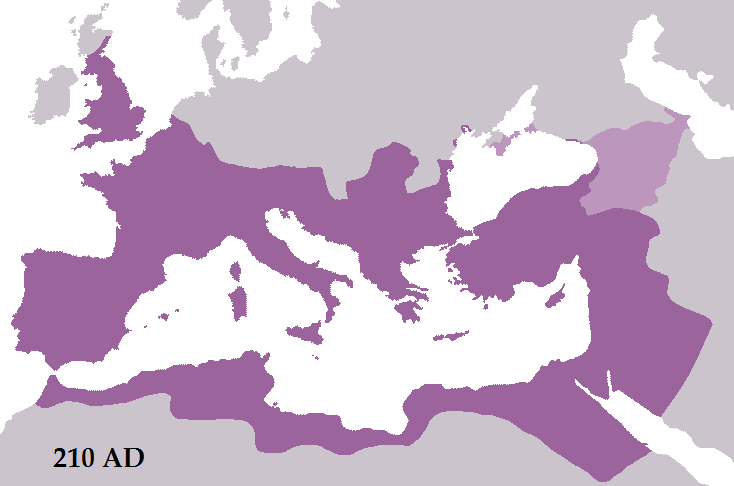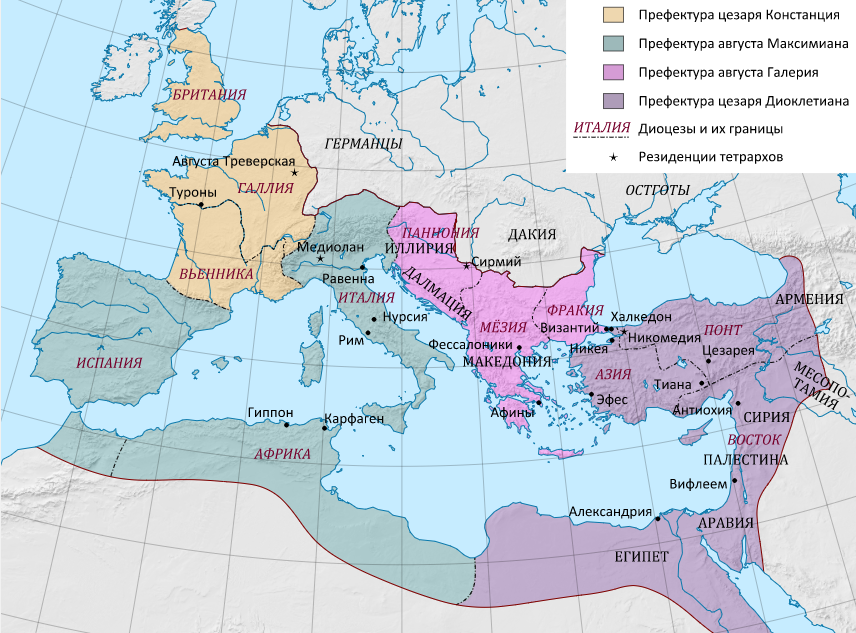Crisis of the 3rd Century in the Roman Empire
The Crisis of the 3rd Century in the Roman Empire is a period in Roman history usually defined as spanning from the assassination of Emperor Alexander Severus in 235 AD to the proclamation of Diocletian as emperor in 284 AD. This period is characterized by a series of crises in the economy, craftsmanship, trade, as well as instability in state authority, internal and external military conflicts, and the temporary loss of Roman control over several regions. Different historical schools have varying perspectives on the causes of these crises, with some even questioning the necessity of distinguishing the 3rd century as a separate period in Roman history.
After the murder of Commodus, the last emperor of the Antonine dynasty, the Roman Empire was plunged into a civil war between 193 and 197 AD. Several prominent leaders declared themselves emperors: Pertinax and Didius Julianus in Rome, the Danube army commander Septimius Severus, the Syrian legions’ commander Pescennius Niger, and Clodius Albinus in Britain. The imperial authority was officially granted by the Senate to the victorious Septimius Severus, who founded the Severan dynasty (193–235 AD).
Most historians consider the political regime under the Severan dynasty to be a "military" or "soldier" monarchy. The increased political involvement of the army and its autonomy in pursuing its political interests is linked to several pivotal trends and moments within the military organization itself, particularly the active measures and reforms of Septimius Severus, who significantly diverged from the traditional military policies and laid the foundations for the late Roman army.
Septimius relied exclusively on the army, and under his rule, the government transformed into a military-bureaucratic monarchy. His foreign policy was marked by a series of successful wars with Parthia (195–199 AD) and the Caledonian tribes (208–211 AD). After the emperor's death, his son Antoninus Caracalla (211–217 AD) murdered his brother Geta, took the throne, started an unjustified war with the Parthians, and was later assassinated by conspirators. His successor, the Praetorian Prefect Macrinus (April 11, 217 – 218 AD), conducted an unsuccessful campaign against the Parthians, with whom he signed a peace treaty unfavorable to the Romans. The army was dissatisfied with Macrinus, whose Eastern habits and luxury drew widespread criticism. Caracalla’s aunt, Julia Maesa, and her two daughters managed to win the army's support for the young Bassianus (Elagabalus), who was proclaimed emperor, with Maesa claiming he was Caracalla’s illegitimate son. Macrinus sent Ulpius Julianus against him, but the soldiers killed Julianus, and the entire army, except for the Praetorians, defected to Bassianus. A battle took place at Antioch, but Macrinus fled before its outcome and was soon killed. After Macrinus, Elagabalus (Elagabal, Bassianus, 218–222 AD) became the ruler of the Roman Empire, but he was killed by his own soldiers in March 222, and a 13-year-old Alexander Severus (222–235 AD) ascended the throne. Under Alexander Severus, the financial crisis worsened, and the growing threat from the emerging Sassanian Empire, with which war began in 231 AD, escalated. Alexander was murdered by mutineers, marking the start of an even deeper political and socio-economic crisis.
 Roman Empire Before the Crisis of the 3rd Century AD
Roman Empire Before the Crisis of the 3rd Century AD
The First Stage of the Crisis
In 235 AD, the period of the "barracks emperors" began, with the empire being shaken by military conflicts between contenders for the throne, and extraordinary tax levies were imposed to supply the opposing armies. Between 235 and 268 AD, 29 emperors were proclaimed (including usurpers), and only one of them, Hostilian, died a natural death (of the plague).
The year 238 AD is known as the Year of the Six Emperors due to the rapid succession of claimants. Ultimately, the Praetorians proclaimed the 13-year-old Gordian III (238–242 AD) as emperor, whose rule lasted several years and was relatively successful. However, the young emperor died during a campaign against the Persians (likely due to intrigues). His successors, Philip the Arab (244–249 AD) and Decius Trajan (249–251 AD), still managed to maintain control of the situation, despite struggling against each other, suppressing military uprisings, and waging wars with external enemies. The death of Decius during a battle with the Goths, in which the Romans suffered a crushing defeat, marked a deepening of the crisis.
A general trend of the first stage of the crisis was that the Romans gradually began to abandon certain territories, which had extremely negative consequences. For example, the Romans began to withdraw from Dacia in the 240s, and by 242 AD, they had left the eastern part of the Wallachian Plain. This weakened Roman influence on the northern coast of the Black Sea.
By the early 240s AD, the rulers of the empire began to consolidate the military forces of several provinces under the command of a single military leader, known as a dux. The military districts (ducati) divided the armed forces into groups, the main ones being the British, Eastern, Danubian, Rhine, and African. In some cases, these groups put forward contenders for the imperial throne, who fought against each other. The system of ducati within the Roman Empire became a major change in the army, not only during the first stage of the crisis but throughout the entire 3rd century AD.
The Second Stage of the Crisis
The second stage of the crisis, which became its climax, is characterized by continuous wars being fought simultaneously against multiple enemies. During this period, Gallienus (253–268 AD) ruled. The emperor, who headed the central authority, was forced to both repel attacks from external enemies and fight against Roman troops supporting usurpers.
The western part of the empire suffered from constant invasions by the Alemanni and Franks, with the former even managing to penetrate Italy in their raids, while the latter ravaged Roman territory as far as southern Spain. The Saxons devastated the coastline, and the Marcomanni managed to secure a concession of part of Upper Pannonia from Gallienus. The eastern provinces of the state were similarly devastated by invasions from the Goths, Persians, and other peoples.
At this stage, the empire began to disintegrate, with the Gallic Empire and the Palmyrene Empire breaking away.
Gallienus took decisive steps to reform not only the army but also, to some extent, the administrative system. Although he was unable to resolve all the problems he faced, his reforms, which did not alter the foundations of the Roman military organization but significantly modified it, created a more mobile army capable of responding promptly to external and internal threats.
The Third Stage of the Crisis
The final stage of the crisis is characterized by the Romans being able to halt the main waves of barbarian invasions. Additionally, Gallienus’ successors, partly by utilizing some of his innovations, managed to stabilize the situation on the borders, halt the processes of disintegration, and even restore the unity of the empire.
A city wall built at the end of the crisis to protect Rome from external threats. The ascension of the "Illyrian dynasty" to power marked the beginning of Rome's gradual emergence from the crisis.
Claudius II Gothicus (268–270 AD) initiated the empire's revival by defeating the Goths and passing the throne to Lucius Domitius Aurelianus (270–275 AD).
Aurelian repelled the invasion of Germanic tribes (who had invaded Italy for the first time), restored Roman administration in the eastern provinces, and subdued the Gallic Empire. After yet another period of turmoil, Marcus Aurelius Carus (282–283 AD) defeated the Germans, and then the Illyrian Diocletian ascended the throne, marking the beginning of the Dominate period (284–476 AD). During Diocletian's nearly 20-year reign, during which he rarely visited Rome, as he was restoring order in various parts of the state, the empire was strengthened, and the situation was relatively stabilized for about 100 years.
 Roman Empire After the Crisis of the 3rd Century AD
Roman Empire After the Crisis of the 3rd Century AD
Results
Even in the pre-crisis period, there was a trend towards the agrarianization of society, with the number of small and medium landowners declining as large estates (latifundia) grew. As a result of the military actions, several cities were destroyed, and trade and craftsmanship fell into decline.
Moreover, the need to defend the borders from invasions by Germanic tribes and the Persian army forced the emperors to excessively expand the army, increasing the maintenance costs that the Roman economy could not sustain. To support the army's supply system, the emperors imposed an enormous fiscal burden on the population and filled the gaps in the treasury through the so-called "currency debasement," issuing coins with a high content of base metals instead of precious ones. This led to hyperinflation. On the other hand, tax collectors were unwilling to collect taxes in the now worthless coinage and instead switched to collecting taxes in kind (in goods). As a result, the empire's economy largely reverted to a barter system. This, in turn, led to the decline of cities, especially in the western part of the empire, with the crisis hitting the most civilized and Romanized regions the hardest.
In the post-crisis period, the economic situation improved somewhat, but the economy as a whole never fully recovered. The pan-imperial market, created in the 1st and 2nd centuries AD, was practically destroyed. There was a general decline in agriculture, craftsmanship, and industry, a deterioration of safety on the roads, and a rise in economic and, consequently, political separatism.
Related topics
Roman Empire, Emperors of Rome, Reign of the Severan Dynasty, Diocletian, Dominate


